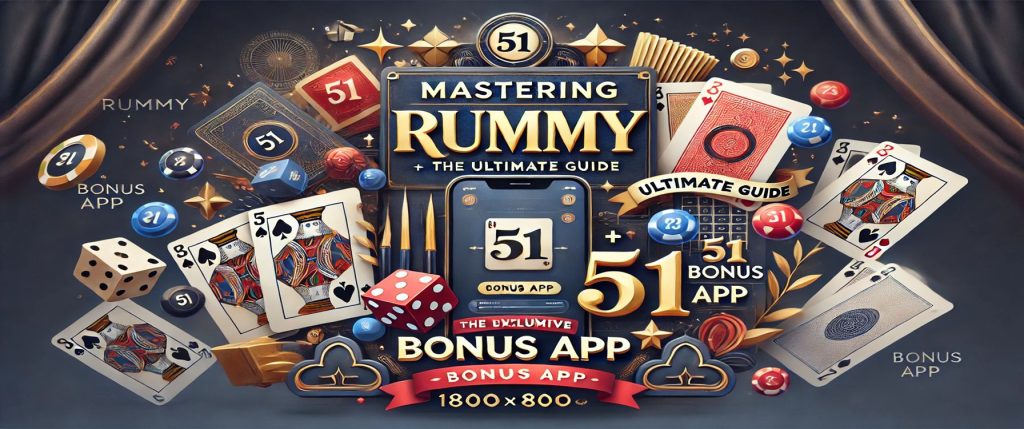Description

The Complete Guide to Rummy The card game rummy date back to the early 1800s and has been a favorite among players for centuries. Even though the game’s exact origins are a little unclear, it is generally accepted that Rummy developed from a number of earlier card games, such as the Spanish game “Conquian,” which is frequently mentioned as a forerunner. Many of the mechanics used in contemporary Rummy were first introduced in Conquian, a game played with a 40-card deck.
Numerous adaptations were made to the game as it traveled across borders, giving rise to the various iterations that are now known to us. In the 1930s, the game gained enormous popularity in the US & became a mainstay at family game nights and social events. As rummy developed further, it gave rise to a wide variety of variants, each with its own rules and tactics.
Its versatility has enabled the game to flourish in a variety of cultural contexts, from the traditional Indian variant known as “Indian Rummy” to the well-liked “Gin Rummy” that became popular in American homes. The fundamental mechanics of rummy, which have stayed the same throughout its history, involve combining cards to form sets or runs. The game’s ability to combine skill, strategy, and chance makes it suitable for both casual players & serious competitors, which explains its enduring appeal.
Rummy is fundamentally a card game in which players form sets and runs from a hand of cards. Three or four cards of the same rank but different suits make up a set, whereas three or more cards in the same suit make up a run. Players try to get better hands by drawing and discarding cards in turn, until they “go out” by melding all of their cards. A standard 52-card deck is usually used for the game, though some variations might use extra decks or jokers.
Anyone wishing to understand the mechanics of rummy must have a solid understanding of these foundational ideas. Each player is dealt a set number of cards at the start of the game; depending on the variation being played, this number is typically between 10 & 14. One card is positioned face-up to begin the discard pile, & the other cards form a draw pile.
At the end of their turn, each player discards one card after drawing from either pile. When another player goes out, the goal is to make valid melds while lowering the total value of unmelded cards in hand. Because players must continuously evaluate their own hands while monitoring the moves of their opponents, Rummy’s balance between offense and defense makes it both strategic and entertaining.
A combination of strategic thinking and astute observation is needed to win at rummy. Keeping a close eye on the cards your opponents are discarding is one useful tactic. Players can learn more about their opponents’ hands and modify their own tactics by keeping track of the cards they discard or pick up. Hold onto similar cards to prevent your opponent from moving forward, for example, if they discard a card you believe they need for a meld.
When every point matters in a high-stakes game, this defensive move can be vital. Having good self-management skills is another crucial tactic. Players should keep their options open for future turns while simultaneously attempting to form melds as fast as possible.
Usually, this entails keeping adaptable cards that can be used in a variety of possible meld combinations. The value of their unmelded cards should also be considered by players; lower-value cards are usually better because they save points in the event that another player leaves the game. Your chances of winning at rummy can be greatly increased by striking a balance between aggressive play and cautious hand management.
After mastering the fundamentals and formulating basic strategies, players can explore more complex strategies that can improve their performance. One such method is “card counting,” which entails monitoring which cards are still in the deck & which have already been played. With the help of this ability, players can decide which cards to draw or discard more intelligently depending on the possibility that their melds will be completed. This method can give you a big advantage over less astute opponents, but it does require practice and focus. Psychological play, which entails interpreting your opponents’ actions and formulating strategic plans in response to their patterns, is another sophisticated tactic.
For instance, if an opponent shows signs of anxiety when discarding particular cards, it might mean that they are about to finish a meld that contains those cards. Utilizing this knowledge, you can modify your approach to either prevent them from playing or compel them to make less-than-ideal plays. When you become proficient in these sophisticated strategies, your gameplay improves and each match gains an intriguing level of complexity. There is a vast variety of rummy variations to suit varying tastes & ability levels, so it is not a single game. Typically played between two players, “Gin Rummy” is a popular variation that focuses on forming sets and runs without letting opponents see your hand until you declare victory. Another popular variation is “Indian Rummy,” where players must create at least two sequences, one of which must be a pure sequence devoid of jokers, and frequently use two decks of cards.
The rules and tactics introduced by each variation have the potential to drastically change the dynamics of the game. Numerous regional variations exist in addition to these well-known versions, reflecting regional tastes & customs. In some parts of Europe, for example, “Kalooki” is a popular variant that uses features like wild cards and particular scoring schemes. Similar to this, “Contract Rummy” adds several rounds with different goals for every round, which increases strategy and complexity. By investigating these various variations, you can not only gain a deeper comprehension of Rummy but also find new ways to enjoy this classic card game.
Playing Rummy online has grown in popularity as digital gaming platforms have grown. However, there are some changes that must be made when switching from traditional tabletop play to online formats. Learn the specific guidelines and user interface of the platform you are using before you start playing online.
Your experience can be improved by taking the time to comprehend the subtle differences between various online platforms, as they may have special features or variations that could impact gameplay. Time management is a crucial component of playing Rummy online. Numerous online games have timers that set a limit on how long you can spend on each turn. Being able to make decisions quickly without sacrificing strategic depth is crucial for success in this fast-paced setting. Also, think about making use of online resources like guides or discussion boards where seasoned gamers exchange tips and tactics unique to online gaming.
Getting involved with these communities can yield helpful hints that improve your abilities and gaming experience. Beyond just being entertaining, playing rummy has many other advantages. It’s a great mental workout that improves cognitive abilities like strategic planning, memory retention, and critical thinking. Since players must continuously assess their hands while monitoring the movements of their opponents, playing games on a regular basis can help players become more focused and attentive.
For older adults who want to preserve their cognitive abilities or for anyone else looking for a fun way to push their minds, this mental stimulation can be especially helpful. Also, rummy encourages players to connect and engage with one another. The game fosters friendship & communication between players whether it is played online or in person. Through online platforms, it offers a chance for friends and family to connect over common experiences & make new acquaintances.
In this way, playing rummy can help you develop relationships and improve your social skills in addition to providing entertainment. The 51 Bonus app provides a cutting-edge platform designed especially for rummy fans who want to improve their game even more. This app gives users access to a variety of rummy games, including well-known variants like Indian and Gin rummy, all within an intuitive interface made for fluid gameplay. The 51 Bonus app’s active community is one of its best features; users can interact with people worldwide, take part in competitions, and even play friendly games against friends. The app also includes a number of bonuses and reward structures that increase user involvement and encourage consistent play.
Through gameplay, players can accrue points that can be exchanged for thrilling rewards or extras inside the app. In addition to making play more fun, this gamification element pushes players to improve their abilities via competition and practice. The 51 Bonus app is an innovative advancement in the field of online rummy gaming because of its accessibility, community involvement, and lucrative gameplay features.
To sum up, rummy is a complex & multidimensional card game with a long history and a wide range of variations to suit different player tastes. There is always something new to discover in this classic game, regardless of your level of experience. For rummy fans worldwide, platforms like the 51 Bonus app are opening the door to an even more interesting and interactive experience as technology advances.



